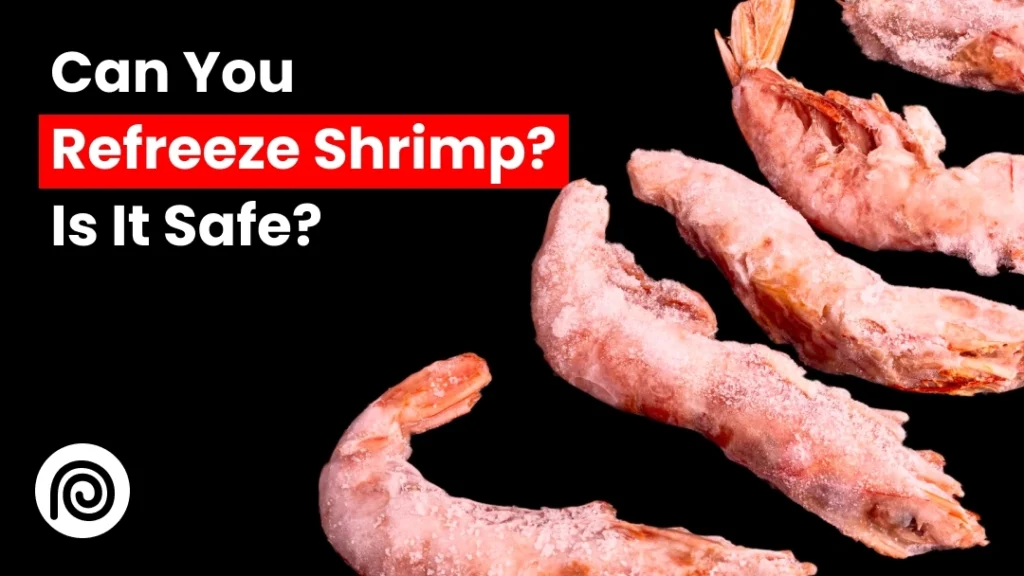Yes, you can refreeze frozen shrimp. But, there are important steps to follow.
Knowing these steps ensures safety and quality. Frozen shrimp is a convenient seafood choice. However, many wonder about refreezing it once thawed. Understanding the correct process is crucial. Food safety is always a priority. Refreezing shrimp can be safe if done right.
But, incorrect refreezing can lead to spoilage. This blog will explain the proper method. It will also highlight key precautions. By following these guidelines, you can enjoy shrimp without worry. Whether for a quick meal or a special recipe, knowing how to handle frozen shrimp is essential. Let’s dive into the details and ensure your meals are both delicious and safe.
Introduction To Frozen Shrimp
Frozen shrimp are a popular choice for many households. They are convenient and easy to store. This seafood option is also versatile and nutritious. It can be used in various dishes, from salads to pasta.
Frozen shrimp are often preferred because they are available year-round. They retain their freshness and flavor when stored properly. This makes them a reliable option for many recipes.
Shrimp Consumption Trends
Consumption of shrimp has increased significantly over the past few years. People appreciate its low calorie and high protein content. Shrimp is also rich in vitamins and minerals. This makes it a healthy choice for many diets.
According to recent studies, shrimp is one of the most consumed seafood in the world. Its popularity is growing due to its health benefits and easy preparation. More people are including shrimp in their weekly meal plans.
Shrimp Freezing Methods
There are several methods used to freeze shrimp. Each method helps to maintain the quality and taste of the shrimp. Here are some common freezing methods:
- Blast Freezing: This method involves freezing shrimp quickly at very low temperatures. It helps to preserve the texture and flavor.
- IQF (Individually Quick Frozen): Shrimp are frozen individually, preventing them from sticking together. This makes it easier to use the exact amount needed.
- Brine Freezing: Shrimp are soaked in a saltwater solution before freezing. This helps to maintain moisture and flavor during storage.
Using these methods ensures that frozen shrimp remain fresh and tasty. Proper packaging also plays a key role in preserving their quality. Vacuum-sealed bags are often used to prevent freezer burn and extend shelf life.

Credit: www.greedygourmet.com
Freezing And Refreezing Basics
Freezing food is a common way to preserve it. But can you refreeze frozen shrimp? Understanding the basics of freezing and refreezing helps maintain the quality of your shrimp. Let’s delve into what happens when you freeze shrimp and the impact of refreezing on its texture.
What Happens When You Freeze Shrimp?
Freezing shrimp stops bacteria growth. The cold temperature slows down the enzymes that cause spoilage. When shrimp is frozen, its water content forms ice crystals. These ice crystals help preserve the shrimp for long periods.
During the freezing process, the size of the ice crystals matters. Small ice crystals form when shrimp is frozen quickly. Large ice crystals form during slow freezing. Small ice crystals cause less damage to the shrimp’s cell structure. Large ice crystals can break the cell walls, leading to texture changes.
Impact Of Refreezing On Texture
Refreezing shrimp can affect its texture. The repeated freezing and thawing process creates more ice crystals. This can lead to a mushy texture. Refreezing also impacts the flavor and moisture content.
To maintain the best quality, follow these tips:
- Thaw shrimp in the refrigerator.
- Avoid leaving shrimp at room temperature.
- Freeze shrimp in airtight containers.
Proper handling helps retain the shrimp’s original texture and flavor. Always be cautious and prioritize food safety.
Safety Concerns
Refreezing frozen shrimp can lead to safety concerns. Understanding these risks is crucial. Not taking proper precautions can result in serious health issues. Let’s explore these concerns in detail.
Bacterial Growth Risks
When shrimp thaws, bacteria can start to grow. This happens especially if it sits at room temperature for too long. The danger zone for bacterial growth is between 40°F and 140°F.
Once bacteria start growing, refreezing won’t kill them. It only stops their growth. When you thaw the shrimp again, these bacteria can become active. Consuming such shrimp can pose health risks.
Always thaw shrimp in the fridge. This keeps it at a safe temperature. Avoid letting it sit out on the counter.
Foodborne Illness Prevention
Preventing foodborne illness is crucial. Follow these steps to stay safe:
- Thaw shrimp in the refrigerator, not on the counter.
- Use thawed shrimp within one to two days.
- If refreezing, ensure shrimp is still cold and hasn’t been at room temperature.
- Label the refrozen shrimp with a date.
These steps help reduce the risk of foodborne illness. Proper handling and storage are key. Always prioritize safety when dealing with frozen shrimp.

Credit: www.greedygourmet.com
Proper Thawing Techniques
Thawing frozen shrimp correctly is crucial to maintain its quality and safety. Incorrect thawing can lead to bacteria growth and spoilage. There are two main methods for thawing shrimp safely: refrigerator thawing and cold water thawing.
Refrigerator Thawing
Refrigerator thawing is the safest method to thaw shrimp. It ensures that the shrimp stays at a safe temperature. Follow these steps for refrigerator thawing:
- Place the shrimp in a bowl or on a plate.
- Cover the bowl or plate with plastic wrap or a lid.
- Put the shrimp in the refrigerator.
- Allow the shrimp to thaw overnight or for at least 8 hours.
This method keeps the shrimp at a safe, consistent temperature, reducing the risk of bacterial growth.
Cold Water Thawing
Cold water thawing is faster than refrigerator thawing. It requires more attention but still ensures safety. Here’s how to do it:
- Place the shrimp in a sealed plastic bag.
- Fill a bowl with cold water.
- Submerge the bag of shrimp in the bowl.
- Change the water every 30 minutes to keep it cold.
- The shrimp should thaw in about 1 hour.
This method is quick and effective, but ensure the water remains cold to prevent bacteria growth.
When Refreezing Is Safe
Many people wonder if it’s safe to refreeze shrimp. The answer is yes, but only under certain conditions. It’s crucial to understand these conditions to ensure the shrimp remains safe to eat. Let’s dive into the specifics.
Conditions For Safe Refreezing
Refreezing shrimp is safe if certain conditions are met. Firstly, the shrimp must have been thawed in the refrigerator. Thawing at room temperature or in warm water can lead to bacterial growth. This makes refreezing unsafe.
Next, the shrimp should not have been out of the fridge for more than two hours. If left out longer, bacteria can multiply quickly. This can spoil the shrimp.
Lastly, refreeze shrimp only if it has been stored properly. It must be in an airtight container or tightly wrapped. This prevents freezer burn and contamination.
| Condition | Requirement |
|---|---|
| Thawing Method | In the refrigerator |
| Time Out of Fridge | Less than two hours |
| Storage | Airtight container or tightly wrapped |
Signs Of Spoiled Shrimp
Even if shrimp was thawed correctly, it can still spoil. Knowing the signs of spoiled shrimp is essential.
- Smell: Fresh shrimp should have a mild, ocean-like smell. A strong, sour, or ammonia-like odor means it’s spoiled.
- Color: Fresh shrimp is usually translucent and gray. Spoiled shrimp often turns opaque, yellow, or has dark spots.
- Texture: Shrimp should feel firm to the touch. If it feels slimy or mushy, it is likely spoiled.
Always check these signs before refreezing shrimp. Eating spoiled shrimp can lead to food poisoning. Stay safe and enjoy your shrimp dishes!
Best Practices For Refreezing
Refreezing frozen shrimp can be tricky. Follow these best practices to ensure your shrimp remains safe and delicious.
Storing Shrimp Properly
Proper storage is key. Always use airtight containers or vacuum-sealed bags. This helps prevent freezer burn.
- Label containers with the date of freezing.
- Store shrimp in the coldest part of the freezer.
- Keep the freezer temperature at 0°F (-18°C).
These steps will help maintain the shrimp’s quality and safety.
Maintaining Shrimp Quality
Quality is crucial. Follow these tips to keep shrimp fresh:
- Thaw shrimp slowly in the refrigerator.
- Never refreeze shrimp that has been left out for more than two hours.
- Use a colander to drain excess water before refreezing.
Keep shrimp in small portions. This makes refreezing easier and faster.
Refreezing shrimp can be safe. Just follow these best practices. Proper storage and handling are vital.
Alternative Uses For Thawed Shrimp
Have you ever thawed shrimp and wondered what to do with it? While refreezing is not recommended, there are many alternative uses for thawed shrimp. Whether you’re looking to cook immediately or explore creative recipes, this guide has you covered.
Immediate Cooking Ideas
Thawed shrimp can be used in various quick and easy dishes:
- Stir-fry: Toss shrimp with vegetables and soy sauce for a quick meal.
- Tacos: Sauté shrimp with spices and serve in tortillas.
- Salads: Add shrimp to your favorite salad for extra protein.
- Grill: Marinate and grill shrimp for a smoky flavor.
Creative Recipes
Looking for more adventurous ways to use thawed shrimp? Try these creative recipes:
- Shrimp Scampi: Sauté shrimp with garlic, butter, and lemon juice. Serve over pasta.
- Shrimp Fried Rice: Mix shrimp with rice, vegetables, and soy sauce.
- Shrimp and Grits: Cook shrimp with creamy grits for a Southern classic.
- Shrimp Ceviche: Marinate shrimp in lime juice with onions, tomatoes, and cilantro.
Using thawed shrimp in these ways ensures you enjoy fresh, delicious meals without waste.

Credit: www.tasteofhome.com
Frequently Asked Questions
Can You Refreeze Thawed Shrimp?
Yes, you can refreeze thawed shrimp if handled properly. Ensure it was thawed in the refrigerator and hasn’t been out for more than two hours. This minimizes bacterial growth and maintains quality.
How Many Times Can You Refreeze Shrimp?
It’s best to refreeze shrimp only once. Repeated freezing and thawing can affect texture and flavor, making it less enjoyable to eat. Always check the shrimp’s freshness before refreezing.
Does Refreezing Shrimp Affect Its Quality?
Refreezing shrimp can affect its texture and flavor. Ice crystals formed during refreezing can damage the shrimp’s cells, leading to a mushy texture. Proper handling minimizes quality loss.
What Is The Best Way To Refreeze Shrimp?
To refreeze shrimp, place it in an airtight container or freezer bag. Remove excess air to prevent freezer burn. Label the container with the date for future reference.
Conclusion
Refreezing shrimp is possible, but caution is essential. Always ensure shrimp stays cold. Thaw shrimp safely to avoid bacteria. Check shrimp for spoilage before refreezing. Store shrimp properly in airtight containers. Quality might decrease after refreezing, so consider using shrimp soon.
Follow these tips to enjoy safe, delicious shrimp dishes. Remember, food safety is crucial. Enjoy your meals with peace of mind.




